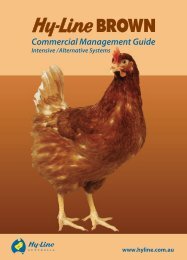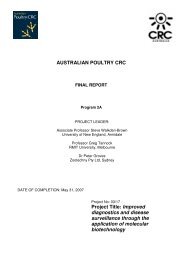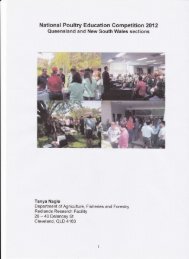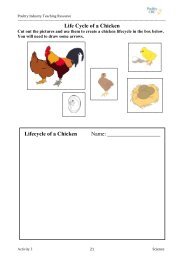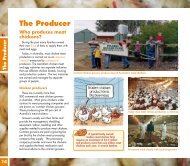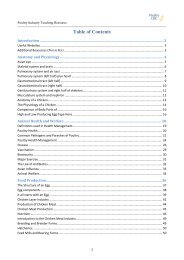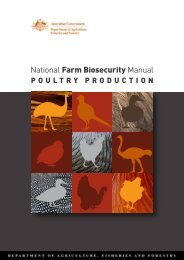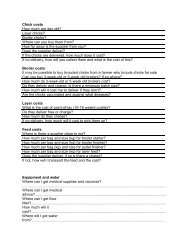You also want an ePaper? Increase the reach of your titles
YUMPU automatically turns print PDFs into web optimized ePapers that Google loves.
et al., 1992; Nir et al., 1994a). However, other studies have shown that the pelleting processdiminishes the effects of particle size and mill type, giving no differences between pre-pellet particlesize treatments (Reece et al., 1985). Feeding sorghum allows better performance than feeding wheatirrespective of particle size, as seen by Nir et al. (1994a). However, it is evident that the particle sizeof the grain has a greater effect on FCR when wheat is fed as opposed to sorghum.Within grain type, the effect of grain particle size on the performance of chicks fed wheat was greaterthan those fed sorghum. The results suggest that the effect of feed particle size on efficiency may berelative to the feeding value of the grain. This is a similar finding to the results of experimentsconducted by Nir et al. (1994a) where the effect of particle size on feed efficiency was greatest insorghum or wheat fed birds as no particle size effects were noted for corn in the same experiment, andsimilar mean particle sizes were attained for the three grind sizes across grains tested. Bothexperiments have demonstrated that a diet with coarse particle sized grain improves AMEn more thanfeed containing fine particles. Furthermore, this effect differs according to the grain used and isexacerbated when whole grain is used in the feed mix (Wu et al., 2004). The AMEn of the wholegrain or coarse textured diets does not, however, relate to improved performance. This may be due toa higher maintenance energy requirement of birds with larger muscular gizzards, adapted to eatinglarge particles. Also, as these birds were extracting more energy from their feed, the ratio of energyexerted (to liberate the energy from the feed) to the extra energy gained may have been higher forthese birds than the birds eating processed grain.It can be concluded that under experimental conditions, sorghum promotes better bird performancecompared with wheat. Regardless of the time of introduction of the feed, e.g., from 1 or 10 d, thebeneficial effects on performance of a coarse particle sized grain as part of the diet are apparent by 21d and continue through to 35 d. The effect of feed particle size on FCR is greater for wheat fed birdsthan sorghum fed birds. Feed conversion can be improved by feeding intermediate-sized (approx. 600µm) roller-milled sorghum compared to hammer-milled sorghum of similar mean particle size andparticle size distribution. In the current study, the AMEn of the feed could be manipulated by theparticle size of the diet, but was not correlated to broiler performance. The AME of wheat diets wasnot affected by particle size, but the AME of the sorghum diet was improved by offering a coarserparticle.4.2.2 Response under commercial production conditionsThe significant differences in performance and gut development seen in broilers under experimentalconditions were not well replicated in the current experiment. One key aspect of the current series ofstudies is the consumption of coarse particles by birds, leading to stimulation of gizzard development,which is, in turn, believed to modulate a cascade of physiological and endocrine changes in the gut.Thus, it should have been expected that under commercial conditions, broilers have access to thebedding material which they consume throughout the production cycle (Hetland, 2007). In the currentstudy, rice husk was used as a litter material and it was observed during the experiment that the birdsregularly consumed it as evidenced by the presence of rice husk in the gizzards of sample birds.The pH of the digesta of the gizzard is affected by the activity of the gastric stomach and thefermentation of carbohydrates in the crop. Retention time in the crop is believed to be positivelycorrelated to the degree of fermentation and production of SCFA (primarily by lactobacilli), andtherefore inversely proportional to pH. Although the estimated concentration of lactobacilli in thegizzard was increased by feeding intermediate or coarse particle sized hammer-milled wheat or coarseroller-milled wheat, the pH was not significantly different between treatments. This would alsosuggest that the barrier function of the stomach to reduce the flow of pathogens to the intestine(Engberg et al., 2002; Engberg et al., 2004; Bjerrum et al., 2005) is reduced by the presence of litter.These effects have been observed recently in work presented by Bohorquez et al. (2006), wherecolonisation of the colifom bacteria, Salmonella, was enhanced in birds reared on litter. This may bedue to the effects of litter on the digesta passage rate through the gizzard, as controlled by its34



